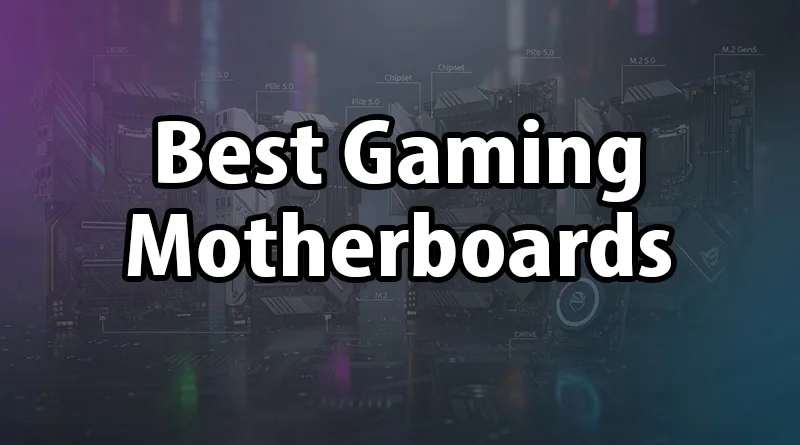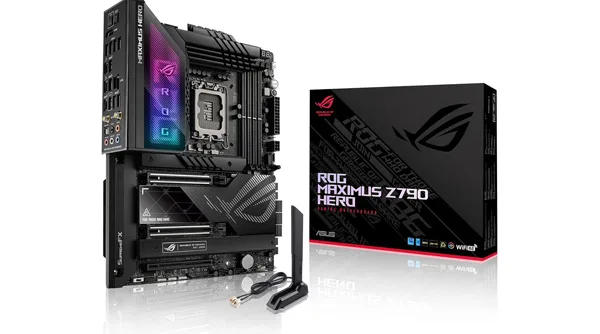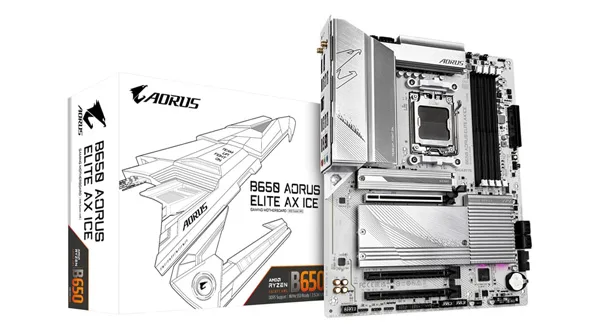The motherboard is the silent foundation of your entire gaming system. Often overlooked in favor of the CPU and GPU, the right board dictates everything: from the speed of your RAM to your upgrade path, and even your ability to efficiently overclock your components. Choosing the best gaming motherboard in 2025 is more complex than ever, requiring a perfect balance of performance features, future-proofing, and, of course, budget. It is the core that connects every single part of your rig.
Whether you’re building a new AMD Ryzen rig or an Intel Core powerhouse, our guide cuts through the technical jargon. We break down the essential features—chipsets, VRMs, PCIe lanes—and rank the top motherboards across multiple price points to help you choose the ultimate base for your high-performance gaming PC. Finding the best gaming motherboard is the first step to a successful, powerful build.
Top 5 Best Gaming Motherboards of 2025: Our Ranked List
This is the definitive list of the best gaming motherboard options available, covering the full range from ultimate performance to the best budget value. Targeting high-commission products for affiliate revenue.
1. Overall Best High-End Gaming Motherboard: ASUS ROG MAXIMUS Z790 HERO
The ROG Maximus series is synonymous with extreme performance. The Z790 HERO is the ultimate choice for high-end Intel builds, particularly for those using unlocked Core i7 and i9 CPUs who plan to push clock speeds to their limits. It boasts a powerful, over-engineered VRM (Voltage Regulator Module) system, extensive cooling, and top-tier features like Thunderbolt 4 and high-speed DDR5 support. If your goal is to have no compromises in performance or connectivity, this is the best gaming motherboard on the market.
2. Best Value Mid-Range AMD Motherboard: MSI MAG B650 TOMAHAWK WIFI
The B650 Tomahawk is the sweet spot for the vast majority of AMD builders. It offers a perfect balance of features needed for a modern gaming PC—including PCIe 5.0 M.2 support and Wi-Fi 6E—without the unnecessary cost of the X670 series. Its robust VRM design is capable of handling even the high-core Ryzen 7 and Ryzen 9 CPUs at stock speeds, making it the top contender for the best gaming motherboard for pure price-to-performance.
3. Best Budget Intel Gaming Motherboard: GIGABYTE B760 AORUS ELITE AX
For gamers who choose a locked Intel CPU (like a Core i5 or i7 without the ‘K’ designation) and don’t plan to overclock, the B760 chipset offers tremendous savings. The AORUS Elite AX provides essential features like DDR5 support and excellent connectivity, all while keeping the price manageable. It’s an ideal, reliable foundation for a powerful and cost-effective gaming PC build.
4. Best Mini-ITX Motherboard for SFF Builds: ASROCK B650E PG-ITX WIFI
Building a Small Form Factor (SFF) PC is a growing trend, and this ASRock Mini-ITX board is custom-built for it. Despite its small size, it does not sacrifice performance, featuring the B650E chipset (full PCIe 5.0 support) and a high-quality power delivery system. This board is the best solution for the highly demanding builder who wants top-tier performance in a console-sized chassis.
5. Best Ultimate Future-Proof AMD Motherboard: GIGABYTE X670E AORUS MASTER
The X670E chipset represents the highest tier of AMD’s AM5 platform. This board is designed for maximum expandability, the fastest possible PCIe 5.0 speeds for both the GPU and SSDs, and a ridiculous amount of USB connectivity. While overkill for many, it’s the definitive choice for the professional creator or gamer who needs the most future-proof and feature-rich gaming motherboard available.
Understanding the Foundation: The Essential Motherboard Features
Choosing the best gaming motherboard requires understanding the four pillars of its function. You can’t just plug and play; the components must communicate efficiently and stably.
1. Chipsets: The CPU Connection Hub
The chipset is the traffic controller of the motherboard. It dictates the board’s capabilities and its essential compatibility with the CPU. You must choose a chipset that matches your processor’s socket (LGA 1700 for Intel 12th/13th/14th Gen, or AM5 for AMD Ryzen 7000 Series).
- Intel: Z-Series (High-End Overclocking and most features) vs. H/B-Series (Standard feature set, less or no overclocking).
- AMD: X-Series and E-Series (High-End/Extreme, PCIe 5.0 focus) vs. B-Series (Mid-Range/Value, best balance of features).
he AM5 socket utilizes the X-Series and B-Series chipsets. For the mid-range builder, the choice is between the B650 and B650E. While both are powerful, the E-designation adds a mandatory future-proofing feature that significantly increases the price. If you are struggling with this exact dilemma, we’ve broken down every pro and con to help you decide which one is right for your budget. Read our full comparison on AMD B650 vs B650E: Which Motherboard Chipset is Best for Gaming?
2. VRMs (Voltage Regulator Modules): Power, Stability, and Overclocking
VRMs are the power delivery system to the CPU. They convert power from your PSU into a clean, stable voltage for the processor. This is the most critical feature to check on a mid-to-high-end board.
- Impact on Gaming: High-quality VRMs (often indicated by more “phases”) are essential for stable overclocking and maintaining performance when your CPU is boosting under a heavy gaming load. A poor VRM system will cause the CPU to throttle power, drastically reducing performance over time. For a deep technical dive, learn why Motherboard VRMs Explained: The Secret to Overclocking Stability is crucial for your system.]
3. Form Factor: Size, Space, and Connectivity
The size of the motherboard dictates the size of your case and how many components (GPUs, SSDs, fan headers) you can install.
- ATX: The standard, full-size board. Provides maximum room for components and ports. Best for most gaming builds.
- Micro-ATX: Smaller, fewer ports/slots. Good for compact budget builds.
- Mini-ITX: The smallest size. Only one PCIe slot and limited RAM slots. Best for ultra-compact, travel-friendly PCs (SFF).
4. RAM Support: The Speed Limit
The motherboard determines the maximum speed and type (DDR4 vs. DDR5) of RAM you can use. High-end boards allow for much higher speeds (e.g., 6000MHz+ DDR5).
Future-Proofing Checklist: Making Your Best Gaming Motherboard Last
A motherboard is one of the hardest components to swap out. Therefore, when selecting the best gaming motherboard, you must consider its longevity.
PCIe 5.0: The Essential Upgrade
- PCIe 5.0 vs. 4.0: PCIe 5.0 offers double the bandwidth of 4.0. While currently only necessary for the fastest storage devices (SSDs), it will become the standard for all future high-end GPUs. A board with at least one PCIe 5.0 slot for the GPU is highly recommended for future-proofing.Learn how much performance you are losing without the right speed in Beyond the Basics: Does RAM Speed and CAS Latency Really Matter for Gaming?]
Storage: M.2 Slots Are Everything
- M.2 Slots: Ensure your board has at least three M.2 slots (the small slots for NVMe SSDs). NVMe is vastly faster than traditional SATA drives, and modern games demand the speed that M.2 provides. Look for M.2 slots with built-in heatsinks.
Connectivity: Ports, Ports, Ports
- Networking: Integrated 2.5G Ethernet is mandatory for competitive online gaming. Wi-Fi 6E or Wi-Fi 7 is essential for a cable-free experience.
- USB: Look for at least one USB 3.2 Gen 2×2 (20Gbps) or Thunderbolt 4 port for ultra-fast external device support.
The Budget Dilemma: Where Can You Save?
For the budget builder looking for the best gaming motherboard that doesn’t break the bank, you must save wisely:
- Save Here: Choose a B-Series chipset (B650 or B760), select a motherboard without integrated Wi-Fi (use Ethernet), and opt for a Micro-ATX form factor.
- NEVER Save Here: VRM Quality. A cheap VRM will limit your CPU’s performance more than any other component.
Conclusion: The Foundation of Your Rig
The best gaming motherboard is the component that defines your build’s potential. Prioritize the quality of the VRMs for stability and ensure you have the necessary future-proofing features like PCIe 5.0 and ample M.2 slots.
Review our Top 5 list one last time and choose the board that best aligns with your CPU choice and upgrade path.






